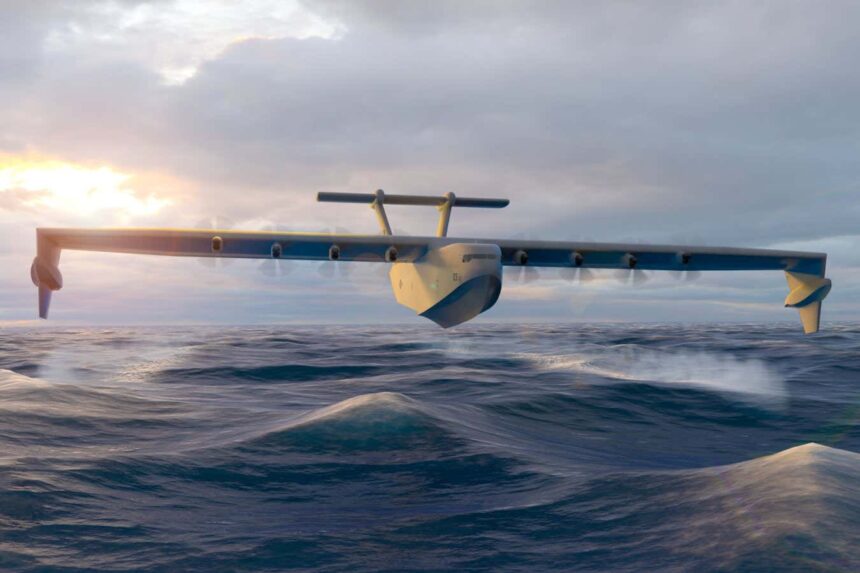
Illustration concept for the US DARPA Liberty Lifter program
Aurora Flight Sciences
It’s not a boat. It’s not a plane. It’s a flying, sea-skimming craft called an ekranoplan.
These large vehicles reminiscent of Soviet technology from the Cold War are making a comeback as China and the US develop modern versions for a possible military confrontation in the Pacific.
The giant sea skimmers resemble large aircraft but are “more akin to high-speed naval vessels in that they ‘fly’ a few metres above the ocean”, says Malcolm Davis at the Australian Strategic Policy Institute. Such vehicles take advantage of a phenomenon called “wing-in-ground” effect, where a cushion of air between the low-flying vehicle and the water below can both support the vehicle and reduce aerodynamic drag.
Such sea skimmers are typically faster than ships – with speeds comparable to aircraft – while also being able to avoid surface or air radar detection, says Davis. They could stealthily and speedily deliver cargo or troops across the long ocean distances common in the Indo-Pacific region, or possibly launch surprise anti-ship missile strikes on opposing navies, he says.
The technology first gained notoriety during the Cold War, when the Soviet Union experimented with its ekranoplan design, including a prototype nicknamed the “Capsian Sea Monster”. But they never fully took off because of a lack of funding and limited usefulness for Soviet military planners, says Davis. The current resurgence of interest in sea skimmers comes as China uses its expanding military power to press territorial claims over Taiwan and the South China Sea.
China began developing sea skimmer prototypes starting in the early 2000s, says Ben Lewis, an independent defence analyst in Washington DC. More recently, in June 2025, pictures emerged from Chinese social media showing a large waterborne vehicle with four jet engines mounted on top of its wings, first reported by the analyst HI Sutton in Naval News. China is also recruiting Russian technology specialists who formerly worked on the Soviet Union’s ekranoplan designs, according to internal Russian intelligence documents obtained by the New York Times.
The US Defense Advanced Research Projects Agency (DARPA) was funding the development of a similar seaplane through its Liberty Lifter program from 2022. But the program ended in June 2025 without building a successful craft. Instead, the agency plans to encourage private companies and the broader US military to take up the task with lessons learned from the Liberty Lifter program.
Separately, the US company Regent Craft has also been testing its all-electric seaglider version of such technology for commercial use, which has drawn interest from the US Marine Corps.
Such sea skimmers “may prove affordable and reasonable alternatives to more expensive traditional aircraft” as the technology and manufacturing techniques advance, says Brendan Mulvaney at the US Air Force’s China Aerospace Studies Institute in Alabama. But, he cautioned, “they are not going to be the backbone of any force, and almost certainly won’t survive modern high-intensity combat”. Such sea skimmers could also face difficulties operating in rough conditions, which are not uncommon in the Taiwan Strait and other waters of East Asia, says Lewis.
Still, sea skimmers could be one part of a broader Chinese military strategy to counter US and allied naval forces that may deploy in support of Taiwan, says Davis. The US has responded by boosting military cooperation with regional allies, such as South Korea, Japan and the Philippines, while seeking to reinforce Pacific Island territories as military bases. The possibility of conflict for both sides has “really elevated the need for the exploration of more novel capabilities” that can provide an “extra edge”, says Lewis.
Topics:






